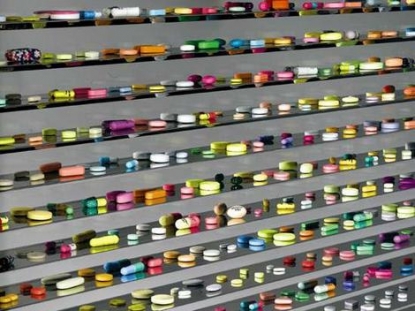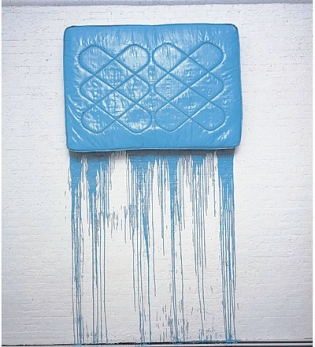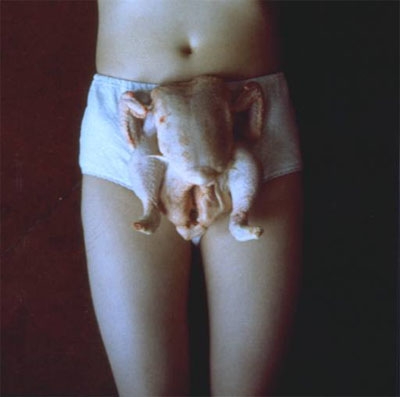Feature: Reviews
Damien’s Follies
- Serpentine Gallery
- London, UK
- November 25- January 28, 2007
by Amy Berk
Although it has taken over six months after seeing In the darkest hour there may be light, works from Damien Hirst’s murderme collection at London’s Serpentine Gallery to put pen to paper (at least digitally), Hirst remains in my consciousness as well as continually in the news. He recently made headlines (again) as the contemporary artist who sold a work for the highest dollar amount.
Hirst’s Lullaby Spring, a stainless steel cabinet containing 6,136 handcrafted and painted pills, has set a record for the highest price paid at auction for a work by a living artist. According to Sotheby’s, the piece sold June 21 for $19.1 million. The sale propelled Hirst past previous best seller Jasper Johns, whose Figure 4 netted about $17 million in New York in May.
Hirst’s works have consistently attracted controversy and huge sums of cash. A leading member of the Young British Artists, a group that dominated the British art scene in the 1990s, Hirst is best known for his work involving slicing up animals and fish and pickling them in formaldehyde. Parts of his provocative collection were recently highlighted in London’s Serpentine Gallery. This is the first time this collection has been shown publicly, but not the first time that he has worked with the Serpentine Gallery—in 1994 he curated the exhibition Some Went Mad, Some Ran Away there.
The murderme collection began with Hirst exchanging work with artists such as Tracey Emin, Angus Fairhurst, and Sarah Lucas. The collection reflects the development of his interests in the macabre and the abject and includes artists from the US as well as the UK. Although most of the artists are Hirst’s contemporaries, a few slipped in from the past and present: for example, Haim Steinbach born in 1944, Andy Warhol in 1928, Francis Bacon in 1909, and Laurence Owen born in 1984.
The work was really all across the board: some abstract, some portraits, a bunch of collages, some politically motivated, and much of it a bit grotesque. As always, I enjoyed Jim Lambie’s contributions, especially his dripping blue double mattress and his psychedelic owl. Sarah Lucas also used fowl, but in a much fouler way with a dead chicken attached to a girl’s panties in Chicken Knickers, 2000. She also exhibited a neon coffin emitting a blue glow, a car with a moving arm, and my personal favorite, a vacuum cleaner covered in cigarette butts titled It Sucks from 1999.
Also showing off his Hoovers was Jeff Koons. New Hoover Celebrity IV and Quik Broom and New Hoover Deluxe Shampoo Polishers were featured as well as The New Lightbox—all from 1980. Yellow Moon, a stainless steel mirrored jiffy-pop-like wall piece from 1995-9, also made the scene. Fellow Americans John Currin, Andy Warhol, and Richard Prince were also represented. While at first glance John Currin’s portraits seem a bit out of place, there is a certain connection to major British painters. The coloring of his ladies gives them an otherwordly vampirish quality that is found throughout the collection. Warhol’s contributions were what would be expected, Little Electric Chair from 1965, Five Deaths from 1963, and Knives from 1981-2, all in keeping with Hirst’s fascination with death and evisceration. Prince’s mostly text pieces are from the early 80s through 2005. They include 5 Jokes Painted to Death which I can imagine is a Hirst favorite on many levels.
It is, however, his fellow YBA’ers that had the strongest showing. Sarah Lucas’s varied mix (mentioned above) serves as almost a mini-retrospective, and her sometime collaborator Angus Fairhurst is represented here by two of his gorilla works as well as his in-your-face Faces collage from 1996. Pieta from 1996 shows a reclining figure (the artist) being held in this classic pose by an empty gorilla suit. A bronze outdoor piece, A Couple of Differences Between Thinking and Feeling II (2003), shown to great effect on the Serpentine lawn, is a life-size ape apparently missing an arm perusing a smaller figure. Both pieces are poignant, witty and just a bit insane, all to great effect.
Also keeping Hirst in the news is his proposed studio in Stroud, Gloucestershire, UK. Residents of this community about one hour from London are not happy about the artist’s plans to build a slaughterhouse there. He has already been given permission to build an “art gallery, workshop and center of excellence”. While in the UK last winter, I watched a television show on Channel 4 focusing on Damien’s folly, a huge house that he is converting into a museum to showcase his work and extensive collection. The well-known house, Toddington Manor, needs a ton of work, but Hirst is planning extensive repairs that will allow some of his best-known oversized pieces to be showcased alongside his collection of other artists’ works.
Although Hirst says he never wanted to be a landowner, he couldn’t resist the bargain. He bought the estate for three million pounds, but plans to spend ten million fixing it up. Here he combines his two fantasies of creating a Hirst Museum and a curiosity museum. “It’s going to be a place where I can make art, put it there and it stays there. I plan to work ten years on it and then have it open by appointment and then maybe when I die, have it open to the public.” Perhaps his involvement with this estate will one day be known as his greatest work of all.
In somewhat related news, Hirst purportedly sold $265 million worth of art from his recent exhibition at London’s White Cube. For you diehard Hirst fans (and you know who you are!), a trip to the Portland Art Museum in Oregon is in your future. The exhibition Camouflage opened in early August, which includes Hirst’s new butterfly work titled The Kingdom of the Father (2007). Rumor has it that Hirst is also building an exhibition space on Newport Street in London where he will curate shows of other people’s work and perhaps his own. He says that he’s never been satisfied with the money split in the gallery relationship.
Moneymaking aside, Hirst’s varied projects beautifully reflect his interests in bringing artworks to a larger audience, “Art for all, yes. Art for fuck’s sake. Art is a great thing.”
In the darkest hour there may be light: Works from Damien Hirst’s murderme collection was on view at the Serpentine Gallery from November 25- January 28, 2007. Toddington Manor is currently undergoing renovations, there is no current opening date. Camouflage is on view at the Portland Art Museum in Portland, Oregon, through November 4, 2007.



